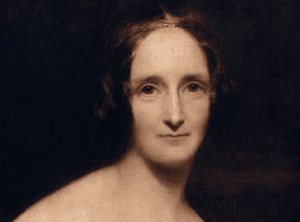Mary Shelley: A Troubled Life

Not many people know that the first great science fiction novel in history was the novel Frankenstein (also called The Modern Prometheus), written by Mary Shelley. Her famous book has since been adapted for film, television, and even cartoons. However, it was written at a time of very few female novelists, and even fewer of them were successful.
Mary Shelley’s life was as fascinating as her work. Terrible tragedies, a great love that she kept in her heart until her death, and boldness and adventure filled her life.
Although Mary Shelley entered the hall of fame of the greatest writers in history with her book Frankenstein, that wasn’t her only novel. She wrote other novels and plays, which, in recent decades, have increasingly caught experts’ attention. However, during her lifetime, the success of this great novel was so great that it overshadowed her other works.

Mary Shelley was a very different girl
Mary Shelley was born in London, England on August 30th, 1797. Her family was clearly very forward-thinking. Mary was always close to her father, philosopher, journalist, and novelist William Godwin. Her mother, Mary Wollstonecraft, was a philosopher and a pioneer of the feminist movement.
Unfortunately, Mary’s mother died giving birth to her. According to reports, she got an infection and the resulting fever spiraled out of control and led to her death. Mary’s mother had her while she was still single, but Mary’s father welcomed her into his family along with a daughter he already had. The two girls grew up as sisters and had a very close relationship throughout their lives.
When Mary was three years old, her father married a woman who had two daughters of her own. By all accounts, Mary came to hate her stepmother. Despite that, she had a happy childhood and adolescence. Her father brought her and her sister Claire up in a very liberal way and gave them a good education.
A secret love
When Mary Shelley was 17, she met poet and writer Percy Bysshe Shelley, who was married. He was 22 years old at the time, and he frequented Mary’s family home as he was her father’s friend. The two began to secretly meet at Mary’s mother’s grave, which was a special place for her. She said that she learned to write by tracing out her mother’s name on her gravestone with her finger.
Mary Shelley had a liberal view of marriage and love. Her father, and society in general, opposed their relationship. However, the lovers fled to Paris, France in the company of Claire, Mary’s stepsister. The couple’s relationship was based on a mutual interest in literature and new ideas. However, Percy often had to move about in order to avoid his creditors.
These separations greatly distressed Mary, who became pregnant in 1814. However, at this time, Percy flirted openly with her stepsister. Mary gave birth in February 1815, but her daughter died before she was a month old. This, quite naturally, plunged her into a deep depression.

A great writer
Shortly after these events, Percy’s wife committed suicide. This caused much of society to reject his relationship with Mary. Because of this, and their debts, they decided to move. They went to Geneva, where they had interesting evenings with Lord Byron, the great poet, who also had a son with Mary’s stepsister. Those evenings inspired Mary, who had a dream about Frankenstein’s plot and started to write it soon afterward.
Mary had two other children with Percy. After that, they went to Italy, where they led a nomadic life. The couple’s eldest son died in 1818 and, a year later, their youngest daughter died. Mary was depressed and sick most of the time. However, in 1819, they had a fourth child, who was the only one who survived.
In 1822, Percy drowned during a trip on a sailing boat. Mary asked to have his body cremated, but asked to have his heart taken out first. Soon after that, she returned to England with her fourth child, Percy Florence. In the final years of her life, Mary suffered paralysis in different parts of her body. She died at the age of 54, probably a victim of a brain tumor.
After her death, people came across her desk when they were looking through her house. In one of the drawers, they found her husband’s heart, wrapped in a piece of silk that contained one of her poems, along with part of his ashes. They also found hair that belonged to her three children who had passed away.
Not many people know that the first great science fiction novel in history was the novel Frankenstein (also called The Modern Prometheus), written by Mary Shelley. Her famous book has since been adapted for film, television, and even cartoons. However, it was written at a time of very few female novelists, and even fewer of them were successful.
Mary Shelley’s life was as fascinating as her work. Terrible tragedies, a great love that she kept in her heart until her death, and boldness and adventure filled her life.
Although Mary Shelley entered the hall of fame of the greatest writers in history with her book Frankenstein, that wasn’t her only novel. She wrote other novels and plays, which, in recent decades, have increasingly caught experts’ attention. However, during her lifetime, the success of this great novel was so great that it overshadowed her other works.

Mary Shelley was a very different girl
Mary Shelley was born in London, England on August 30th, 1797. Her family was clearly very forward-thinking. Mary was always close to her father, philosopher, journalist, and novelist William Godwin. Her mother, Mary Wollstonecraft, was a philosopher and a pioneer of the feminist movement.
Unfortunately, Mary’s mother died giving birth to her. According to reports, she got an infection and the resulting fever spiraled out of control and led to her death. Mary’s mother had her while she was still single, but Mary’s father welcomed her into his family along with a daughter he already had. The two girls grew up as sisters and had a very close relationship throughout their lives.
When Mary was three years old, her father married a woman who had two daughters of her own. By all accounts, Mary came to hate her stepmother. Despite that, she had a happy childhood and adolescence. Her father brought her and her sister Claire up in a very liberal way and gave them a good education.
A secret love
When Mary Shelley was 17, she met poet and writer Percy Bysshe Shelley, who was married. He was 22 years old at the time, and he frequented Mary’s family home as he was her father’s friend. The two began to secretly meet at Mary’s mother’s grave, which was a special place for her. She said that she learned to write by tracing out her mother’s name on her gravestone with her finger.
Mary Shelley had a liberal view of marriage and love. Her father, and society in general, opposed their relationship. However, the lovers fled to Paris, France in the company of Claire, Mary’s stepsister. The couple’s relationship was based on a mutual interest in literature and new ideas. However, Percy often had to move about in order to avoid his creditors.
These separations greatly distressed Mary, who became pregnant in 1814. However, at this time, Percy flirted openly with her stepsister. Mary gave birth in February 1815, but her daughter died before she was a month old. This, quite naturally, plunged her into a deep depression.

A great writer
Shortly after these events, Percy’s wife committed suicide. This caused much of society to reject his relationship with Mary. Because of this, and their debts, they decided to move. They went to Geneva, where they had interesting evenings with Lord Byron, the great poet, who also had a son with Mary’s stepsister. Those evenings inspired Mary, who had a dream about Frankenstein’s plot and started to write it soon afterward.
Mary had two other children with Percy. After that, they went to Italy, where they led a nomadic life. The couple’s eldest son died in 1818 and, a year later, their youngest daughter died. Mary was depressed and sick most of the time. However, in 1819, they had a fourth child, who was the only one who survived.
In 1822, Percy drowned during a trip on a sailing boat. Mary asked to have his body cremated, but asked to have his heart taken out first. Soon after that, she returned to England with her fourth child, Percy Florence. In the final years of her life, Mary suffered paralysis in different parts of her body. She died at the age of 54, probably a victim of a brain tumor.
After her death, people came across her desk when they were looking through her house. In one of the drawers, they found her husband’s heart, wrapped in a piece of silk that contained one of her poems, along with part of his ashes. They also found hair that belonged to her three children who had passed away.
All cited sources were thoroughly reviewed by our team to ensure their quality, reliability, currency, and validity. The bibliography of this article was considered reliable and of academic or scientific accuracy.
Tirado, G. P. (2012). Vida artificial y literatura: mito, leyendas y ciencia en el Frankestein de Mary Shelley. Tonos digital: Revista electrónica de estudios filológicos, (23), 36.
This text is provided for informational purposes only and does not replace consultation with a professional. If in doubt, consult your specialist.







